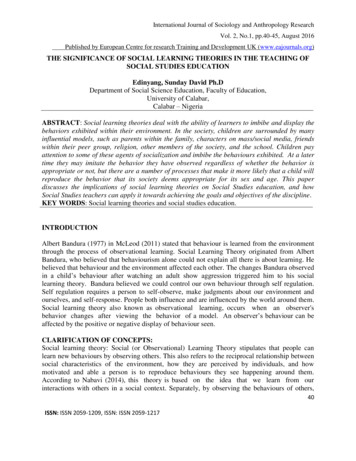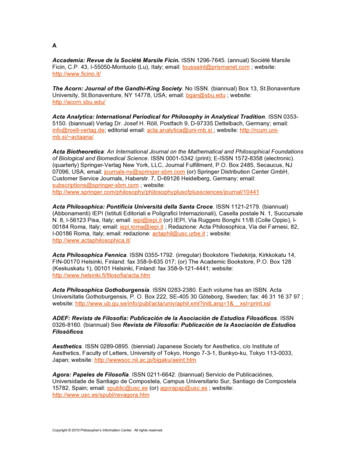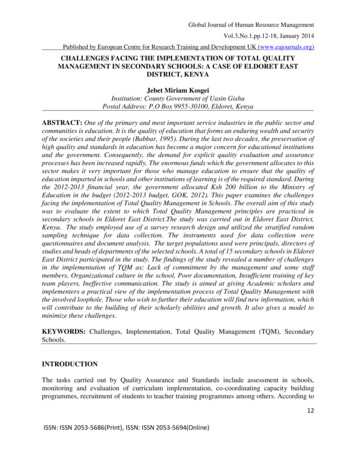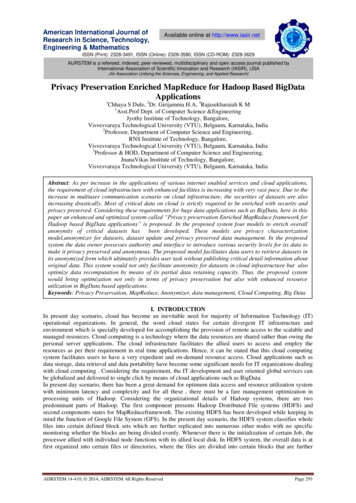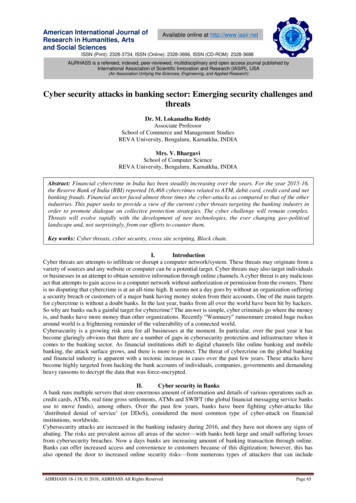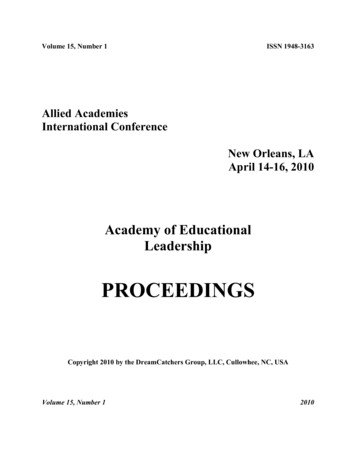
Transcription
Volume 15, Number 1ISSN 1948-3163Allied AcademiesInternational ConferenceNew Orleans, LAApril 14-16, 2010Academy of EducationalLeadershipPROCEEDINGSCopyright 2010 by the DreamCatchers Group, LLC, Cullowhee, NC, USAVolume 15, Number 12010
page iiNew Orleans, 2010Allied Academies International ConferenceProceedings of the Academy of Educational Leadership, Volume 15, Number 1
Allied Academies International Conferencepage iiiTable of ContentsGENIUSOLOGY AND GENIUS EDUCATIONMETHODOLOGY: A GENIUS SOLUTION FORFASTEST GROWTH, DEVELOPMENT, ANDIMPROVEMENT . . . . . . . . . . . . . . . . . . . . . . . . . . . . . . . . . . . . . . . . . . . . . . . . . . . . . . . 1Andrei G. Aleinikov, International Academy of GeniusDavid A. Smarsh, International Academy of GeniusTHE PROFESSIONAL WRITING INITIATIVE:PROVIDING SUPPORT FOR BUSINESS STUDENTS . . . . . . . . . . . . . . . . . . . . . . . . . 2Stephen C. Betts, William Paterson UniversityAndrew McCarthy, William Paterson UniversityTHE IMPORTANCE OF TEACHING PRESENCE INONLINE AND HYBRID CLASSROOMS . . . . . . . . . . . . . . . . . . . . . . . . . . . . . . . . . . . . 7Richard Bush, Lawrence Technological UniversityPatricia Castelli, Lawrence Technological UniversityPamela Lowry, Lawrence Technological UniversityMatthew Cole, Lawrence Technological UniversityTHE IMPACT VOLUNTARY ACCOUNTABILITY ONTHE DESIGN OF HIGHER EDUCATION ASSESSMENT . . . . . . . . . . . . . . . . . . . . . 14Beth Castiglia, Felician CollegeDavid Turi, Felician CollegeIMPACT OF BEHAVIORAL FACTORS ON GPA FORGIFTED AND TALENTED STUDENTS . . . . . . . . . . . . . . . . . . . . . . . . . . . . . . . . . . . 16David Deviney, Tarleton State UniversityLaVelle H. Mills, West Texas A&M UniversityR. Nicholas Gerlich, West Texas A&M UniversityCarlos Santander, West Texas A&M UniversityPREDICTING AND MONITORING STUDENTPERFORMANCE IN THE INTRODUCTORYMANAGEMENT SCIENCE COURSE . . . . . . . . . . . . . . . . . . . . . . . . . . . . . . . . . . . . . 19Kelwyn A. D'Souza, Hampton UniversitySharad K. Maheshwari, Hampton UniversityProceedings of the Academy of Educational Leadership, Volume 15, Number 1New Orleans, 2010
page ivAllied Academies International ConferenceEVALUATING GLOBAL COURSES OR PROJECTS FORCONTEXTUALIZED CRITICAL THINKING . . . . . . . . . . . . . . . . . . . . . . . . . . . . . . . 24Laura E. Fitzpatrick, Rockhurst UniversityCheryl McConnell, Rockhurst UniversityFACTORS THAT INFLUENCE SUCCESS FORSTUDENTS REPEATING ACCOUNTING PRINCIPLES . . . . . . . . . . . . . . . . . . . . . . 25Katherine A. Fraccastoro, Lamar UniversityClare Burns, Lamar UniversityCHESS IN RURAL ARKANSAS:PAST, PRESENT AND FUTURE . . . . . . . . . . . . . . . . . . . . . . . . . . . . . . . . . . . . . . . . . 26Robert S. Graber, University of Arkansas at MonticelloGuy Nelson, University of Arkansas at MonticelloCOMMERCIAL VS. INTERNALLY DEVELOPEDSTANDARDIZED TESTS: THE CASE OF A SMALLREGIONAL SCHOOL . . . . . . . . . . . . . . . . . . . . . . . . . . . . . . . . . . . . . . . . . . . . . . . . . . 29Costas Hadjicharalambous, SUNY - College at Old WestburyLynn Walsh, SUNY - College at Old WestburyCHANGING FROM ONE TO FOUR MBAPROGRAMS: THE PROCESS OF CREATINGBOUTIQUE MBA PROGRAMS AT WKU . . . . . . . . . . . . . . . . . . . . . . . . . . . . . . . . . . 30Robert D. Hatfield, Western Kentucky UniversityTHE RETAIL INVENTORY METHOD:A TEACHING NOTE . . . . . . . . . . . . . . . . . . . . . . . . . . . . . . . . . . . . . . . . . . . . . . . . . . . 31John Hathorn, Metropolitan State College of DenverSUCCESSION . . . . . . . . . . . . . . . . . . . . . . . . . . . . . . . . . . . . . . . . . . . . . . . . . . . . . . . . . . . . . . . 32Kevin R. Howell, Appalachian State UniversityCOMMUTER STUDENTS: INVOLVEMENT ANDIDENTIFICATION WITH AN INSTITUTION OFHIGHER EDUCATION . . . . . . . . . . . . . . . . . . . . . . . . . . . . . . . . . . . . . . . . . . . . . . . . . 33John J. Newbold, Sam Houston State UniversitySanjay S. Mehta, Sam Houston State UniversityPatricia Forbus, Sam Houston State UniversityNew Orleans, 2010Proceedings of the Academy of Educational Leadership, Volume 15, Number 1
Allied Academies International Conferencepage vRECALL AND THE SERIAL POSITION EFFECT: THEROLE OF PRIMACY AND RECENCY ONACCOUNTING STUDENTS' PERFORMANCE . . . . . . . . . . . . . . . . . . . . . . . . . . . . . . 36Emmanuel O. Onifade, Morehouse CollegeDuane M. Jackson, Morehouse CollegeTina R. Chang, Morehouse CollegeJerry Thorne, North Carolina Agricultural & Technical State UniversityCheryl Allen, Morehouse CollegeSHOPPING EFFORT CLASSIFICATION:IMPLICATIONS FOR SEGMENTING THE COLLEGESTUDENT MARKET . . . . . . . . . . . . . . . . . . . . . . . . . . . . . . . . . . . . . . . . . . . . . . . . . . . 37Robert E. Wright, University of Illinois at SpringfieldJohn C. Palmer, Quincy UniversityVicky Eidson, Quincy UniversityMelissa Griswold, Quincy UniversitySKILLS THAT STUDENTS PERCEIVE AS IMPORTANT . . . . . . . . . . . . . . . . . . . . . . . . . . 43Abbie Gail Parham, Georgia Southern UniversityThomas G. Noland, University of South AlabamaJulia Ann Kelly, Georgia Southern UniversitySTUDENT USE OF AN ONLINE TEXTBOOK:EVEN IF IT'S FREE, WILL THEY BUY IT? . . . . . . . . . . . . . . . . . . . . . . . . . . . . . . . . 44Sherry Robinson, The Pennsylvania State University/Buskerud University CollegeDISTANCE LEARNING IN A CORE BUSINESS CLASS:DETERMINANTS OF SUCCESS IN LEARNINGOUTCOMES AND POST-COURSE PERFORMANCE . . . . . . . . . . . . . . . . . . . . . . . . 50Derek Ruth, Purdue University CalumetSusan E. Conners, Purdue University CalumetCOGNITION & RISK PERCEPTION IN BUSINESSENVIRONMENTAL SUSTAINABILITY EDUCATION . . . . . . . . . . . . . . . . . . . . . . . 56Randolph E. Schwering, Helzberg School of ManagementINTRODUCTORY ACCOUNTING FOR BUSINESSMAJORS: REVISITED . . . . . . . . . . . . . . . . . . . . . . . . . . . . . . . . . . . . . . . . . . . . . . . . . 57Bonnie P. Stivers, Morehouse CollegeKasim Alli, Clark Atlanta UniversityEmmanuel Onifade, Morehouse CollegeRuthie Reynolds, Howard UniversityProceedings of the Academy of Educational Leadership, Volume 15, Number 1New Orleans, 2010
Allied Academies International Conferencepage 1GENIUSOLOGY AND GENIUS EDUCATIONMETHODOLOGY: A GENIUS SOLUTION FORFASTEST GROWTH, DEVELOPMENT, ANDIMPROVEMENTAndrei G. Aleinikov, International Academy of GeniusDavid A. Smarsh, International Academy of GeniusABSTRACTDevelopment of Geniusology (the science of genius, Aleinikov, 2003) leads to understandingthat genius is not a person with high IQ, but a person who either solves a problem of greatimportance faster or a person who arrives to a great solution first. A simple proof lies in the factthat huge numbers of people with high IQ never do anything great or are recognized as great. Onthe other hand, some geniuses of the past (very well recognized) had relatively low IQs, and one ofthem was even called "a genius with the IQ of a moron." The Geniusology definition of genius asa mega-recognized mega-innovator stands against both these counter examples. In addition to thenew definition, Geniusology demystifies the concept, debunks the traditional myths of genius, offersa new classification of geniuses, and provides a new methodology of studying geniuses. Thisre-defining of genius makes it possible to teach genius thinking and genius behavior to achieveoutstanding results very fast. Since people are the backbone of every system, the development ofGenius Education Methodology (GEM, already labeled "the GEM of education" by the media)provides the fastest way to any growth and improvement. If you take into account the statement"Nature has no problems; People do," then aiming at people to achieve the fastest result ineducation and training, technology and science looks like a genius solution to all problems.Examples of application of Genius Education Methodology to students, teachers, schools, centers,colleges in Pakistan, Russia, Singapore, South Africa, Thailand, and the U.S.A. only illustrate howsuccessful this approach can be. For more information please see www.academyofgenius.com andwww.lawsofconservation.com.Proceedings of the Academy of Educational Leadership, Volume 15, Number 1New Orleans, 2010
page 2Allied Academies International ConferenceTHE PROFESSIONAL WRITING INITIATIVE:PROVIDING SUPPORT FOR BUSINESS STUDENTSStephen C. Betts, William Paterson UniversityAndrew McCarthy, William Paterson UniversityABSTRACTEmployers emphasize that proficiency in business writing is a critical skill that they seek injob applicants. They also point out that recent college graduates are frequently deficient in thisarea. In this presentation we will briefly outline our recent initiative to diagnose problematic areas,develop assessment rubrics, and design procedures and protocols for improving student writing.Then we will facilitate a workshop style discussion of ways to improve student business writing,drawing on the experiences and ideas of session attendees. Finally we will explore possible designsfor writing centers located in a college of business.INTRODUCTIONThe importance and value of proper business writing has been recognized at least since 1396when Thomas Sampson wrote his book "Modus Dictandi" or "Method of Letter Writing" (Thomas,2003). Modern Employers and business educators recognize that writing skills are among the mostimportant skills to posess (Quible & Griffin, 2007). Feedback from a variety of our stakeholdersconsistently pointed to business writing skills as being critical for success but somewhat lacking inour graduates. We knew that 'writing across the curriculum' programs were frequently used fordeveloping business writing skills (Carnes, Jennings, Vice & Wiedmaier 2001) however thoseprograms met with mixed success (Plutsky & Wilson, 2001). Programs that were successful useda faculty centered approach (Farrington Pollard & Easter, 2006). Interdisciplinary approaches(Krajicek, 2008) and those that use writing within the context of a class (Prater & Rhee, 2003) wereamong the most successful business writing efforts, especially when there is active help from theinstructor (Pittenger, Miller & Allison, 2006). An alternative for or supplement to writing acrossthe curriculum approaches is a business writing center. Such centers function most effectively whenthey coordinates with the classroom faculty (Griffin, 2001).Schools used many mechanisms for improving writing. Some started in the freshman yearwith an 'abstract writing' assignment (Cox, Bobrowski & Maher, 2003).Some use online approaches to learn business writing (Karr, 2001), using web-based lessonsand self-tests (Cleaveland & Larkins, 2004) and even blogs (Quible, 2005). Some schools usedutilized peer feedback to improve writing skills (Holst-Larkin, 2008; Rieber, 2006). One schooleven combined online methods with peer review and used virtual teams to correct and edit eachother on a discussion board (Barker & Stowers, 2009).New Orleans, 2010Proceedings of the Academy of Educational Leadership, Volume 15, Number 1
Allied Academies International Conferencepage 3We decided to start with a measured approach and start with a diagnostic phase, however weknew it was possible to assess writing while still providing meaningful feedback (Fraser, Harich,Norby, Brzovic, Rizkallah & Loewy, 2005). The use of heuristics (Hershey, 2007),guidelines (Jameson, 2006) and rubrics (Rau, 2009) had been shown to help with writing assessmentand development. We decided to start by using course embedded assignments, and develop a rubricfor assessing student writing.OUR WRITING INITIATIVEIn an effort to enhance student writing on the part of Cotsakos College of Business students,a plan was proposed and implemented consisting of the following: Data gathering of student writingEditing of student writingComparison of student writing before and after these effortsAssessment of student writing using a specially designed rubricEstablishment of future stepsMETHODOLOGYThe plan was to provide feedback several times for each student (and applied in two classes:Marketing, and Management) and see if their writing improved over the course of one semester.The student writing would be measured against rubric components that included such metrics as"staying on topic," "answering the question," and "use of grammar and punctuation." That is,students would be required to practice good sentence structure and form as well as to articulate intheir writing proper business-related logic.Initially, use of five assignments was planned. Because only one Writing Coach acted asassessor, this proved a bit too ambitious; the contact protocols were inefficient. The result was alogistical logjam and inconsistent feedback. The 'logjam' was addressed my extending paperdeadlines. Instead of comprehensive feedback to each student on each assignment, the WritingCoach targeted his comments on areas of particular need on a paper-by-paper basis. In that way thefeedback was still very useful to the students.For the Fall 2009 semester portion of the Project, fewer assignments with wider timeframeswere instituted and most certainly smoothed the overall process. In addition, with the addition of aneffective, clear rubric as a definitive metric, students knew at the outset what their writing will bemeasured against.The Management Class cohort was approached as a needs analysis. The class provided a'proof of concept' or trial run for incorporating editing/writing advice into the course. Studentsresponded positively to coaching, rubric measures, editing, and in-class analysis of student work.Also very helpful was advice online and in-person from the Writing Coach, who had oversight withstudent writing for the duration of the term (15 weeks). This was repeated in the Fall.Without apriori established rubrics or research protocol, needs analysis was accomplishedthrough a multi-method approach that had as its basic components:Proceedings of the Academy of Educational Leadership, Volume 15, Number 1New Orleans, 2010
page 4 Allied Academies International ConferenceA writing survey (see Table 1)Analysis of student writingIn-class discussionStudent feedbackIn-class workshopsLiterature searches.Table 1Writing Survey QuestionsQuestion 1Question 2Question 3Question 4Question 5Question 6Question 7Question 8Question 9Question 10Question 11Do you like to write?Do you consider yourself a good writer?What constitutes 'good writing' in your opinion?Has writing come easily to you over the years? Why or why not?Does it help to have someone edit your writing?What did past teachers do to help your writing?How is your Grammar?How is your Spelling?How is your Punctuation?How is your Sentence Structure?Do you like to read?OUTCOMESFrom the methodology and structure of the project, several outcomes were garnered. Firstwas an identification of general level of student writing. That is, strengths and weaknesses,particular problems, central tendencies, and range of abilities. Through our survey we also wereable to ascertain students perceptions of writing (survey results available on request). Our secondoutcome was a rubric for evaluating student business writing (rubric available on request). Westarted with the New Jersey State Core Content Curriculum Standards, and adjusted for theparticular demands of business writing (from literature search and stakeholders meetings) and thecurrent level of our students writing (from needs analysis). We left the project with the knowledgethat this type of project, with steady implementation, will clearly help students write better andenhance the quality of student performanceThe Editing/Writing advice proved to be quite important. A project of this nature has toprovide help to the students while being developed; therefore, a 'learn-as-we-go' approach to helpingstudents was appropriate. We started with the idea of providing feedback on five small assignmentsper student, augmented by class visits from the 'writing coach'. In practice, it was unfeasible toprovide substantive feedback in a timely basis for so many assignments. The two in-class visitsconsisted of one lecture/discussion by the writing coach (with invited guests), and one editingworkshop. The needs analysis conducted in the management course helped when this objective wasresumed in the fall as did a streamlined workload and goal structure.New Orleans, 2010Proceedings of the Academy of Educational Leadership, Volume 15, Number 1
Allied Academies International Conferencepage 5FUTURE PLANWe plan to etend the project out by involving more classes in the project: We started withmanagement and marketing during the first semester, and have included finance, accounting andfinancial planning in subsequent semesters. These course contained a variety of differentassignments. In addition, the Writing Coach will continue to gather data and work with bothstudents and professors. Using rubrics, we hope that assessmnet will show that steady tutorials resultin better writing. By using the rubrics in different classes with a variety of assignments we candevelop the feedback processes, hone the rubrics and develop optimal procedures to improve studentwriting.REFERENCESBarker, R. T., & Stowers, R. H. (2009). Team virtual discussion board: Toward multipurpose written assignments.Business Communication Quarterly, 72(2), 227-230.Carnes, L. W., Jennings, M. S., Vice, J. P., & Wiedmaier, C. (2001). The role of the business educator in a writingacross-the-curriculum program. Journal of Education for Business, 76(4), 216.Cleaveland, M. C., & Larkins, E. R. (2004). Web-based practice and feedback improve tax students' writtencommunication skills. Journal of Accounting Education, 22(3), 211.Cox, P. L., Bobrowski, P. E., & Maher, L. (2003). Teaching first-year business students to summarize: Abstract writingassignment. Business Communication Quarterly, 66(4), 36.Fraser, L., Harich, K., Norby, J., Brzovic, K., Rizkallah, T., & Loewy, D. (2005). Diagnostic and value-addedassessment of business writing. Business Communication Quarterly, 68(3), 290-305.Golden, D. (2006, Nov 13). Colleges, accreditors seek better ways to measure learning. Wall Street Journal, pp. B.1.Griffin, F. (2001). The business of the business writing center. Business Communication Quarterly, 64(3), 7079.Hershey, L. (2007). The 3d writing heuristic: A meta-teaching technique for improving business writing. MarketingEducation Review, 17(1), 43-47.Holst-Larkin, J. (2008). Actively learning about readers: Audience modelling in business writing. BusinessCommunication Quarterly, 71(1), 75-80.Jameson, D. (2006). Teaching graduate business students to write clearly about technical topics. BusinessCommunication Quarterly, 69(1), 76-81.Karr, S. S. (2001). LEARNING business writing ONLINE. Financial Executive, 17(4), 64-64.Krajicek, J. (2008). Effective communication is "hitched to everything in the (business) universe". BusinessCommunication Quarterly, 71(3), 369-373.Pittenger, K. K. S., Miller, M. C., & Allison, J. (2006). Can we succeed in teaching business students to writeeffectively? Business Communication Quarterly, 69(3), 257-263.Proceedings of the Academy of Educational Leadership, Volume 15, Number 1New Orleans, 2010
page 6Allied Academies International ConferencePlutsky, S., & Wilson, B. A. (2001). Writing across the curriculum in a college of business and economics. BusinessCommunication Quarterly, 64(4), 26-41.Pollard, R. P. F., & Easter, M. (2006). Writing across curriculum: Evaluating a faculty-centered approach. The Journalof Language for International Business, 17(2), 22.Prater, E., & Rhee, H. (2003). The impact of coordination methods on the enhancement of business writing. DecisionSciences Journal of Innovative Education, 1(1), 57-71.Quible, Z., & Griffin, F. (2007). Are writing deficiencies creating a lost generation of business writers? Journal ofEducation for Business, 83(1), 32.Quible, Z. K. (2005). Blogs and written business communication courses: A perfect union. Journal of Education forBusiness, 80(6), 327-332.Rau, H. (2009). Implementation of rubrics in an upper-level undergraduate strategy class. Southern Business Review,34(2), 31.Rieber, L. J. (2006). Using peer review to improve student writing in business courses. Journal of Education forBusiness, 81(6), 322-326.Thomas, M. W. (2003). Textual archaeology: Lessons in the history of business writing pedagogy from a medievaloxford scholar. Business Communication Quarterly, 66(3), 98-105.New Orleans, 2010Proceedings of the Academy of Educational Leadership, Volume 15, Number 1
Allied Academies International Conferencepage 7THE IMPORTANCE OF TEACHING PRESENCE INONLINE AND HYBRID CLASSROOMSRichard Bush, Lawrence Technological UniversityPatricia Castelli, Lawrence Technological UniversityPamela Lowry, Lawrence Technological UniversityMatthew Cole, Lawrence Technological UniversityABSTRACTThe Community of Inquiry (COI) model provides a comprehensive view of how instructorscan enhance the learning experience by understanding three dimensions of higher-order thinking:social, cognitive and teaching presences. The purpose of this study was to determine the extent towhich the COI model distinctly exists in blended and online courses in a university setting. Goalsof the study included determining the psychometric properties of the COI model, examining therelationships between COI and demographic variables, and providing recommendations instructorscan use to improve teaching presence in virtual classrooms. First- and second-order factor analysisand ANOVA provided critical results regarding both the importance of teaching presence, and theconnection between teaching presence and student satisfaction with the learning experience. Thefindings of this study indicate that student satisfaction can be enhanced by improving teachingpresence. The results further suggest that students may exhibit significant gains in the learningexperience when relevant teaching techniques and interactions are effectively applied by theinstructor. Implications and applications are presented aimed at improving teaching effectivenessin blended and online course delivery.INTRODUCTIONThe development of a learning community is based on the members of that classroomcommunity having feelings of belonging and trust. Students need to feel that they are safe; free toexpress themselves; trust that members' educational needs will be met through their commitmentto shared goals (McKeachie, Svinicki, & Hofer, 2006). Castelli's (1994; 2006) research on themotivation needs of adult learners reinforces this view where findings of the study showed aninverse effect on motivation if instructors fail to establish and maintain trust. McKeachie, et al.(2006) and Castelli's (1994; 2006) works imply that an important role of the instructor is to establishan environment that is safe for participants to express themselves, where trust is established, andparticipant contributions are acknowledged and valued.The Community of Inquiry (COI) model of Garrison et al. (1999) provides a comprehensiveview of how the instructor can enhance the learning experience by understanding three dimensionsof higher-order thinking that occur when a group is gathered for the common goal of learning. Asshown in Figure 1, the dimensions of COI are social, cognitive and teaching presences, and GarrisonProceedings of the Academy of Educational Leadership, Volume 15, Number 1New Orleans, 2010
page 8Allied Academies International Conferenceet al. felt that educational experiences were maximized in a "community of inquiry" environmentcomposed of instructors and students who demonstrate critical thinking, interpersonal andinteraction skills. According to the COI model, the successful classroom is safe and welcoming. Themodel also assumes that valuable learning in online and blended courses is a function of theinteraction between social presence, cognitive presence and teaching presence (Arbaugh, 2007).Figure 1 - Community of Inquiry (COI ) Model (Arbaugh, 2007)Com munity of InquirySuppor tingDisc our seSOCIALPRE SEN CECOGNITIVEPR ESEN CEE DUC ATIONALE XPE RIEN CES ettingClim ateS elec tingContentTEAC HING P RES ENC ECognitive Presence:The extent to which learners are able to construct and confirmmeaning through sustained reflection and discourse in a criticalcommunity of inquiry.Social Presence:The ability of participants to identify with the community (e.g.course of study), communicate purposefully in a trustingenvironment, and develop interpersonal relationships by way ofprojecting their individual personalities.Teaching Presence:The design, facilitation, and direction of cognitive and socialprocesses for the purpose of realizing personally meaningfuland educationally worthwhile learning outcomes.Communication MediumThe purpose of this study was to determine the extent to which the COI dimensions of social,cognitive and teaching presence distinctly exist in blended and online courses in a university setting.The goal of the study was threefold: Determine the relationships between COI and demographicvariables, address the implications of these findings, and provide recommendations instructors canuse to improve teaching presence in virtual classrooms. The following research questions wereaddressed:1.To what extent does social, cognitive and teaching presences relate to demographiccharacteristics (gender, age, degree status)?2.To what extent does the relationship between social, cognitive and teaching presencessupport online and blended communities of inquiry?3.To what extent does the relationship between teaching presence (instructor interaction) andstudent satisfaction exist in an online and blended COI model?Data for this study were collected over two phases. In the first phase, data from the authors'institution were analyzed to help understand and explain ways to increase learning effectiveness forblended and online courses by focusing on teaching presence. In the second phase, data fromparticipants recruited from other colleges and universities are being collected and will be analyzedin the future to expand the results and improve generalization.METHODSA total of 97 students enrolled in blended courses (a mix of on-ground and online deliverycomponents) and online-only courses served as participants during the first phase of this study. MoreNew Orleans, 2010Proceedings of the Academy of Educational Leadership, Volume 15, Number 1
Allied Academies International Conferencepage 9than 65% of the students were male (n 64), half were undergraduates (n 47), 27% (n 26) wereenrolled in online-only courses, 59% (n 58) were enrolled in a mixture of online and blendedcourses, and 14% (n 13) were enrolled in blended-only courses. Using email communications,each student was invited to voluntarily participate in the study by filling out a 20 minute web-basedsurvey in the fall semester of 2007. Research was approved by the Lawrence Tech IRB.Participants responded to a 50-item survey designed by Shea et al. (2005). Sixteen itemsassessed demographic and educational characteristics, and 34 items assessed the COI model:teaching presence (13 items), social presence (9 items), and cognitive presence (12 items). Theseitems were scored according to a 5-point Likert scale, from strongly disagree 1 to strongly agree 5. COI items were subjected to reliability testing and assessment of internal consistency(Cronbach's alpha), face-validity, and construct validity via exploratory factory analysis (EFA) andconfirmatory factor analysis (CFA). EFA was conducted in SPSS using principle axis factoring asthe extraction method, followed by direct oblimin rotation (Comrey & Lee, 1992), and CFA wasconducted in Mplus using maximum likelihood estimation. We also used SPSS to conduct ANOVAin order to examine the connection between COI dimensions, learning context, student satisfaction,and knowledge in online courses. In the present study, we focus on the impact of the teachingpresence dimension.RESULTS AND DISCUSSIONResults of reliability analyses found excellent internal consistency for the full COI model(? .974), teaching presence factor (? .969), social presence factor (? .922), and cognitivepresence factor (? .963).According to the EFA, three factors with eigenvalues greater than 1.0were extracted. These factors accounted for 71% of the variance of the 34 items that comprise theCOI model. Of the three factors, teaching presence and cognitive presence items loaded very wellfor our sample, with item loadings ranging from .412 to .943. Items on the social presence factoralso loaded very well, ranging from .346 to .838. However, 5 of the 9 social presence itemscross-loaded on the cognitive presence factor. In evaluating the CFA results, models that are goodrepresentations of the data have a ?2/df ratio of less than 2 to 1, a CFI and TLI value ? .90, and aRMSEA that is less than .08 (Bentler, 2007). For this study, the higher-order CFA model had thefollowing goodness of fit indices, which met many of the requirements for an acceptable fit: ?2508 801.51, p .001, CFI .911, RMSEA .077 (.067-.087). Second-order CFA loadings were allsignificant: teaching presence .722, social presence .685, and cognitive presence 1.086. Takentogether, our results indicate the COI model had good psychometric properties in our sample. Futureanalyses with the addition of the phase 2 participants will test the reliability and validity of the COImodel in students from multiple institutions.Tables 1 and 2 present ANOVA results in which the relationships between COI dimensionsand course satisfaction, course knowledge and learning context were examined. As shown in Table1, teaching presence is significantly related to both course satisfaction and course knowledge.Specifically, participants who were satisfied with both the course and the knowled
PROVIDING SUPPORT FOR BUSINESS STUDENTS.2 Stephen C. Betts, William Paterson University Andrew McCarthy, William Paterson University THE IMPORTANCE OF TEACHING PRESENCE IN . Costas Hadjicharalambous, SUNY - College at Old Westbury Lynn Walsh, SUNY - College at Old Westbury CHANGING FROM ONE TO FOUR MBA PROGRAMS: THE PROCESS OF CREATING


